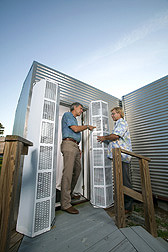This page has been archived and is being provided for reference purposes only. The page is no longer being updated, and therefore, links on the page may be invalid.
Read the magazine story to find out more. |
|
|
Keeping Mosquitoes Out of Foreign Airspace
By Sharon DurhamApril 4, 2007
First, air curtains—those huge blowers at some commercial establishments' entrances and exits—were tested for use on airplanes to keep mosquitoes and other flying insects from getting on. Now, Agricultural Research Service (ARS) scientists in Gainesville, Fla., are trying the same technology to also keep insect pests from getting off planes after landing.
Pesky mosquitoes can really travel around, but not always under their own power. Sometimes they hitch rides in commercial aircraft, and that can pose problems internationally. Some countries, especially those with high levels of tourism, want assurances that any insects that may be on a plane when it arrives will not leave the aircraft.
Recently retired chemist Dave Carlson, entomologist Jerome Hogsette and colleagues in the Mosquito and Fly Research Unit at the ARS Center for Medical, Agricultural and Veterinary Entomology, in Gainesville, have investigated this alternative control approach.
Hogsette and colleagues tested the air curtains' ability to blow hitchhiking insects back into the cabin while passengers disembark. A minimum airflow of 6,000 cubic feet per minute is sufficient to prevent insects from passing through. Placing net curtains or screens impregnated with safe-to-handle pesticides across front and rear doors kills any insects that may attempt an escape. To control insects that may remain, aerosol sprays can be used after all crew and passengers have left the aircraft.
Health officials from several Caribbean countries have shown interest in using air curtains to prevent insect escapes from incoming flights. Currently, in-flight spraying of passengers, crew and crew quarters is done to prevent accidental introduction of invasive species into the country. It is hoped that air curtains can provide a viable alternative to chemical sprays that currently raise health concerns.
Read more about the research in the April 2007 issue of Agricultural Research magazine.
ARS is the U.S. Department of Agriculture's chief scientific research agency.

